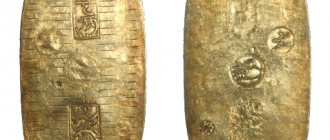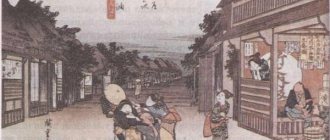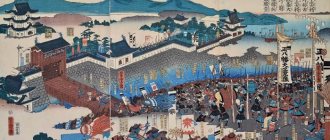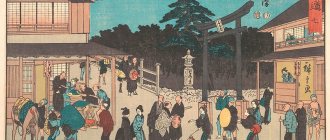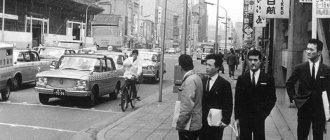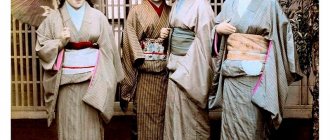Early 18th century
Historians draw the first data about the history of Japan of this period from the records of sailors and traders. The notes of J. Hardy, an English merchant and writer, are considered the most valuable for historical science. He wrote: “We saw a country of extraordinary beauty with a highly developed culture. It had a strong army and a national idea, however, the first problems had already begun to be seen in the economic sphere: the people were poor, the ruling elite was swimming in gold. Japan in the 18th century."
The first attempt to cope with the unstable socio-economic situation of the country belongs to shogun Yoshimune (1716-1745). He went down in history as the author of the Kokhb reforms:
- Administrative reform. The shogun decided to leave the administration unchanged. The Supreme Overlord ordered the replacement of about 80% of the administration, making it more civilian (he fired the samurai and daimyo).
- Financial reform. The position of Minister of Finance appeared. The person in charge controlled the financial activities of the city magistrates and bakufu. The Minister of Finance was also responsible for finding schemes to improve the governance structure.
- Fight against excesses. The shogun ordered luxury, rich food, lazy samurai, gambling to be removed from the palace and banned lavish celebrations.
- Fight against corruption. The death penalty was imposed for the bribe. In addition, all relatives were charged a huge fine for not teaching their neighbor morality and honesty.
- Policy of saving public funds. Yoshimune reduced the number of gokenin and hatamoto (local managers who were supported by the state).
- He ordered an increase in the area under rice cultivation. Yoshimune also established a system of awards for the best rice fields. This policy made it possible to get rid of food problems forever and laid the foundation for the opening of Japan.
JAPAN IN THE XVI–XVIII CENTURIES
In early modern Japan there was a rigid class system. The state established the rules of life for all classes and strictly monitored their compliance. All inhabitants of the country were divided into four classes: warriors, peasants, artisans and merchants. Courtiers, clergy, doctors and scientists, as well as pariahs - untouchables who did the dirtiest work - were not included in the estates. In this class system there was a strict hierarchy in which samurai warriors occupied the top level (at the turn of the 17th–18th centuries, together with their families, they made up approximately 10% of the country’s population). Belonging to this class was inherited; it included senior military leaders, princes, rich feudal lords, ordinary soldiers, high and low officials. In the 17th century the “code of honor” of the samurai was finally formed - “bushido”, according to which they had to lead a harsh lifestyle, be content with little, engage only in military affairs, be unquestioningly obedient and loyal to their master (a large feudal lord, prince) up to the point of being ready to accept death through ritual suicide (harakiri) at his first request or in the event of his death. But at the beginning of the 18th century. The first signs of disintegration of the class system appeared. In particular, samurai appeared who, for various reasons, abandoned their duties and lost their livelihood.
The bulk of the population were peasants who belonged to the second stage of the class system of Japan. The sustenance of the warrior class depended on them. The peasants could not leave their farms; their lives passed in hard work and poverty. They grew rice, sowed wheat, barley, millet, as well as cotton, tobacco, tea, etc. They dressed
peasants wore clothes made from hemp and cotton (women wove and sewed clothes). Government decrees prescribed peasants what to eat and how to dress. And although the peasants worked tirelessly, they were always in debt, and if there was a crop failure and there was no rice to pay the tax, they had to turn to moneylenders and borrow money against the future harvest. When things got really bad, the peasant sold the land (although this was prohibited by law) or even abandoned it and went to look for a better life. If a peasant received permission to leave the village, then the entire community had to cultivate his land and pay taxes for him.
The third and fourth estates in society were craftsmen and merchants. Most artisans lived in cities, but there were also wandering artisans who wandered around the villages. As a rule, the son inherited his father's profession.
As for merchants, in the 16th–18th centuries. the authorities did not like them and were wary of them. Merchants were at the very bottom of the class hierarchy; they were considered “parasites” who did not produce anything themselves. However, the development of the commodity-money economy led to an increase in this class and an increase in its wealth. Neither samurai, nor peasants and artisans could do without their services: money was borrowed from them, surplus grain and handicrafts were sold to them. The merchants lived according to the rules they established with the money they received from daily trade. The rules of Japanese merchants included: getting up early, devotion to family business, working overtime, frugality, good health. All this was supposed to contribute to the accumulation of money and capital. Developed in Japan in the 16th–18th centuries. commodity-money relations gradually led to the disintegration of the class system.
Development of culture and science
Shogun Yoshimune did not ignore science. He contributed in every possible way to its development. For example, in 1742, he allowed European books on natural and applied sciences to be imported into Japan. The shogun invited Europeans (mostly Dutch) who were interested in the culture and history of Japan to the capital, the city of Edo. In addition, at the court he organized centers for cultural exchanges between Japanese and foreigners. Japanese scientists quickly mastered the English language and began to improve domestic knowledge in mathematics, astronomy and medicine. It is worth noting that in other areas, Japanese culture remained conservative.
Thus, the cultural history of Japan in the 18th century remained at the same level as in the 17th century - the national idea continued to improve, Buddhism and Shintoism strengthened. Foreign culture and customs were perceived by ordinary Japanese as alien and strange. Japanese culture during this period remained deeply conservative in theater, music, painting and philosophy. The culture continued to use old motifs, styles and patterns.
What does it mean?
First of all, it is worth emphasizing: the Eastern understanding of creativity is somewhat different from the Western one. We, light-headed gaijins, to be honest, have always valued art in art more: the very embodiment of measure and harmony under the shadow of a veil of ideas. Only in the middle of the 19th century - with the advent of impressionism and the advent of the avant-garde era - did the walls of the temple of academic culture begin to shake somewhat. But they survived. To this enlightened day, the creations of modern art evoke bewilderment and cynicism in the unprepared viewer. In the Eastern world (that environment, which includes Japan, which we are considering), a cultural tradition has formed, which should be assessed not so much from the position of skill, but through the prism of Zen Buddhism. Researchers identify several fundamental concepts that help to understand the Japanese aesthetic worldview. Many of them are difficult to interpret, and particularly tricky aspects can only be understood after simmering in that civilizational soup for a couple of generations. But you and I will try to understand them, right? The concept of the “fluid world” runs through the entire Japanese culture. Beauty is determined not by frailty, dying away to make way for the new, but by variability. Change occurs not in destruction, but in rebirth. Nothing disappears without a trace, it remains to live in a different form - and this is a very important point. To describe the state of the soul at the moment of realizing the ephemeral nature of the world, a special term was invented - “mujo”. Another important concept, “monono aware,” originated in the 10th century, but only fully blossomed in the classical Heian era (IX-XII centuries). It literally means “the sad charm of things” - the captivating elegance hidden in frailty and transience. If monono aware implies admiration of obvious beauty, then yugen, described in the 13th century, expresses a non-rational understanding, an intuitive comprehension of the essence of things, read between the lines. Another important aesthetic principle was formed quite late, in the 17th century, but it still remains decisive not only in art, but in the entire culture of Japan. We're talking about wabi-sabi. “Wabi” and “sabi” are inverted concepts; they mean approximately the same thing, but from different positions of awareness, it is difficult to unambiguously translate them. This is “modest simplicity”, and “detachment”, and “muffledness on the verge of disappearing colors and sounds”. Often the concept of “nare” is intertwined here - a velvety patina of time, like loose snow, conducive to leisurely contemplation. When a single stroke is missing to perfection, but it is never completed, it is wabisabi. And when you admire a thing faded with age, worn out by many hands, which retains the stamp of its former grace, this is also wabi-sabi. When charm, sensitivity, awareness of the essence behind the shine of things and the ability to detachedly contemplate the tragedy of endless loneliness under the muddy haze of time merge together, Japanese aesthetics is born. And now that you are ready to perceive the sublime, forget about it! Because our story is not about subtle matters, but about the strangest art of Japan.
Japan in the second half of the 18th century
During this period, in the Land of the Rising Sun, the contradictions in society that had been growing for several centuries began to be clearly visible. The penetration of European books into Japan contributed to the development of population mobility and structural changes in the city.
The second half of the 18th century was remembered by the Japanese for natural disasters: earthquakes, hurricanes and two droughts in 1770 and 1771. A famine began in the country, from which several hundred thousand Japanese died. In 1772, a large fire was added to the list of disasters, and in 1773 a typhus epidemic began, which claimed 140 thousand lives.
Natural disasters have had a negative impact on treasury revenues. The government tried to plug the holes by increasing taxes. Tanuma Okitsugu, who introduced the policy of mercantilism, achieved noticeable success in this matter. He introduced strict controls over the flow of government money into and out of it. The shogun understood that another important source of replenishment of the treasury was trade, so he gave the green light to the creation of trade associations, which quickly began to transform into monopolies.
Japan at the end of the 18th century almost completely lost its monarchical system. The power of the ruler became nominal. Domestic political power was concentrated in the hands of bureaucrats. All affairs in the state began to be managed by state advisers - rbdzyu.
Japan under the Tokugawa shoguns (XVII - XVIII) domestic and foreign policy
Internal:
Japan consisted of scattered principalities - daimers, headed by influential princes (feudal lords) - daimyos. Noble samurai served under their leadership. Despite the fact that the country was officially led by the emperor, political power was in the hands of the shogun.
One of the main historical events of that time was the unification of the three islands of Japan into a single centralized feudal state.
After a period of feudal fragmentation and civil wars between various principalities known as the Sengoku Jidai Period ("Era of the Warring States"), Japan was reunited into a single state.
After the battle of Sekigahara in 1600, supreme power in Japan passed to Tokugawa Ieyasu, the founder of the dynasty. In 1603, Shogun Tokugawa Ieyasu managed to unite all the lands under his rule. Achieve this through military campaigns and commercial activities. In the conquered territories, he established his own rules and took tribute from the local population, and took away mines for the extraction of precious metals from local feudal lords, amassed a large fortune, and became a monopolist in the field of precious metals.
During the reign of the shogunate, Japan was a federation. A quarter of the state's territory was owned by the Tokugawa shogun family, and the rest by three hundred provincial daimyo lords. Daimyo were divided into classes of "relatives", "old vassals" and "new vassals", in accordance with the degree of subordination to the shogun. They owned personal independent fiefs, the area of which was determined by the capital's leadership. To prevent revolts, the government curtailed the political opportunities of its subjects by the “Laws of Military Houses”, in addition, it reduced the wealth of their possessions by necessary trips to the seat of government in Edo. The shogunate also took away all the land plots of the emperor's house, guaranteeing to maintain them at its own expense.
The dominant feudal class was divided under the Tokugawa into several classes. The court nobility - kuge, formally occupied the most privileged position, but in fact had no power. Like the emperor, they received support from the shogun.
The military nobility formed the class of samurai, the top of which were the ruling princes - daimyo, after the samurai came the peasants, then the artisans, and the last step was occupied by merchants (merchants).
The Tokugawa shogunate established itself during the period when Europeans began to penetrate Japan. Back in the 16th century. Japan was discovered by the Portuguese, who traded with the Japanese for 50 years. In 1552, the Spaniards appeared in Japan, then the Dutch and the British. The Christian religion began to spread in Japan, which was preached among the Japanese by missionaries from Europe. At first, the Japanese supported the missionaries and Jesuits, but then they realized that, under the guise of religion, the Europeans were trying to limit the independence of Japan and seize it.
External:
In the early years of his reign, Shogun Ieyasu supported trade with Europeans, although he did not want to deal with them. Trade disputes with China provoked him to take control of all trade with foreigners. In 1612, Shogun Ieyasu allowed Christians to trade only a certain group of goods, and then not in all cities. The new ruler ordered the peasants living in Japan to renounce their faith. The disobedience of ardent Christian believers triggered a series of reprisals against defenseless ministers of a foreign church. Samurai professing the Christian faith rose up to defend unarmed Christians. The largest revolt ended with the defeat of the rebels in the city of Shimabara in 1638. From that moment on, Christianity was banned in the country. The final closure of Japan in the 17th century dates back to 1641, when any contact with the outside world was limited to a small port on the island of Dejima.
The policy of trade with foreigners has changed. The Japanese began to prevent foreigners from interfering in the country's internal affairs. In the 30s. XVII century The government of shogun Tokugawa Iemitsu took a number of measures to isolate Japan from the outside world.
Since 1624, the British stopped visiting Japan. That same year, the Spaniards, who were considered the most dangerous opponents of Japanese independence, were expelled from the country. Only persons who did not belong to the Christian religion had the right to engage in trade abroad.
And finally, in 1636, the Portuguese were expelled, and Japan was completely “closed” to foreigners. All Japanese, regardless of their religion, were prohibited from traveling abroad.
No Japanese could come to Japan from abroad under pain of death penalty. A few Dutch remained in the country, but they were prohibited from traveling to other parts of the country or moving away from the ports. In 1641, they were resettled on the shores of Nagasaki Island and lived as prisoners.
From the 17th to the mid-19th century, despite the severance of communication with Europe, Japan maintained political and trade relations with its old partners: Korea, China, and the Ryukyu. The Japanese traded with these countries in Tsushima, Dejima, Satsuma and southern Hokkaido.
The grace of fish carcass
In the Japanese mind, art does not necessarily have to be something sublime or requiring great skill. It turns out that to become an artist, it is enough to smear a fish (squid, octopus or some other flat-bodied sea reptile) with paint and make its imprint on paper. This ancient technique is called "gyotaku", "fish print". In fact, everything is not so simple, although this does not change the essence of the matter. A similar fingerprint technology was widely used to copy documents in China at the beginning of the 7th century, from where it subsequently penetrated to Japan, where strict recording of caught fish by size and species composition was introduced. And only later, in the middle of the 19th century, Japanese fishermen began to use it to capture rare specimens as a keepsake. Cameras back then were more exotic than the rarest fish. A simple practice, isn't it? It’s hard to even call this art. But this impression lasts exactly until the moment when you personally try to smear the crucian carp with paint and slap it on the paper. The result of such creativity is a smeared blot in the shape of a fish. Reaching the level of detail at which a print can be called gyotaku is a very labor-intensive process. First, the trophy is washed, then cleaned of mucus with a salt mixture, covered with ink based on soot and animal glue, and applied to rice paper. Afterwards, you can add bright colors to the monochrome print, add eyes and other details. True gyotaku is a ritual. You must catch the fish yourself, take a print and then eat it. Recognized masters believe that only in this case can the tradition of the practice be fully respected, otherwise “all the value and meaning behind gyotaka are thrown aside.” Aerobatics: do all this with a still living fish in the most harmless way possible for it and release the unfortunate creature into the wild. Nowadays, the Japanese themselves consider this art old-fashioned, but foreigners, who have learned about it relatively recently, are happy to join the ancient tradition. What is one man's trash is another man's treasure. By the way, about trash!
The political system of China at the end of the 18th century
China in the 18th century was the largest state in Asia. The multinational empire was united under the rule of the powerful Manchu Qing dynasty (ruled since 1616). At the head of the Qing Empire was the Bogdokhan.
At the end of the 18th century, Qianpong was the Emperor of China. The time of his reign (1735-1796) became the apogee of Qing power. The figure of the emperor was the pinnacle of power. He had absolute power.
Note 2
The Emperor of China headed six main ministries: the Council of Revenue, the Council of Civil Appointments, the Council of War, the Council of Punishments, the Council of Rites and the Council of Works.
The peculiarity of the Qing Empire was that all important government posts were occupied by representatives of the Manchus and Chinese. The equal distribution of senior positions was strictly controlled; two people were appointed to each position: a Manchu and a Han. The Chinese were entrusted with executive functions, the Manchu controlled the observance of loyalty to the ruling dynasty. An important function was performed by the Great Council, first convened in 1720. it was the secret council under the emperor and the central governing body of the country.
— — Do you need help creating a study plan? — Specify a topic and receive a response in 15 minutes — — — — — — get help — —
The entire population of the state is divided into five estates:
- Qizhen - these included the descendants of the Manchus;
- shi shenshi - educated, learned men;
- Nun - the largest class of farmers;
- gun - craft people;
- shan - merchants, trading people.
Korea in the 18th century remained a vassal of the Qing Empire, so the government structure almost completely copied the Chinese system. The ruling dynasty in Korea was the House of Joseon.
Russian expeditions
As a result of numerous expeditions, valuable information was collected, which was published in the essay “Description of the Alon State”. Ivan Kozyrevsky gave an expanded geographical description of the discovered country, main cities, traditions and customs, agricultural conditions, indicated the crops grown, soil and farming characteristics. Information was obtained through questioning local residents and Japanese who were in captivity, that is, from indirect sources.
Japan learned of the existence of a country in the north called Orosia (Russia) around 1739. Russian ships approached the shores of the provinces of Awa and Rikuzen. The coins received by the population from the Russians were delivered to the government. High-ranking officials turned to the Dutch living in Japan, who reported the place where the coins were minted.
Russian pioneers sailed the Sea of Okhotsk and founded settlements in what is now Khabarovsk Krai, but the advance did not create lasting Russian-Japanese relations. Then relations between Russia and China worsened, and Japan faded into the background. This was also facilitated by its self-isolation, the meager settlement of the island of Hokkaido (due to the harsh climate, the Japanese did not seek to develop new territories), the lack of a fleet in both countries, and the loss of Primorye by Russia.

